Do All Terrain Tires Last Longer
This post contains affiliate links. As an Amazon Associate, we earn from qualifying purchases.
All-terrain tires generally do not last as long as standard tires due to their softer rubber, which is designed for grip on varied surfaces like gravel and pavement. While standard tires often last between 60,000 and 80,000 miles, all-terrain tires typically range from 50,000 to 70,000 miles under optimal conditions. More detailed insights and factors affecting their lifespan will be discussed further in the article.
Essential Facts in 30 Seconds
- All-terrain tires last between 50,000 to 70,000 miles with proper care.
- They wear out faster than standard tires due to softer rubber.
- Harsh driving and rough roads shorten their lifespan.
- Regular maintenance, such as tire rotation, can increase their durability.
- Standard tires generally last longer than all-terrain tires because of harder rubber.
Factors Affecting All Terrain Tire Lifespan
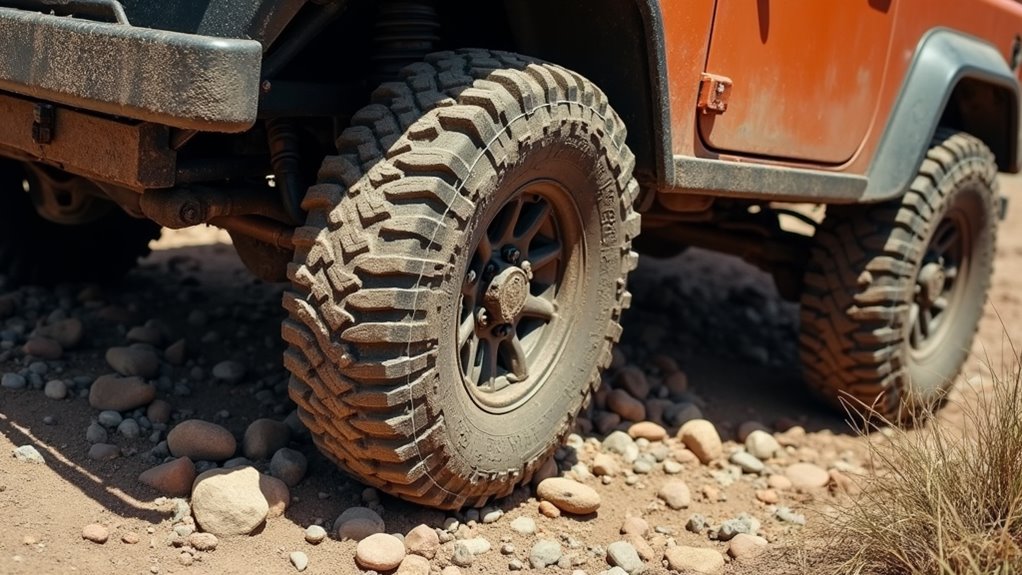
Tires for all terrains last longer with proper care. Many factors play a role in their lifespan.
Think about how you drive—harsh braking wears them out fast. Rough roads also damage tires over time. Data shows 50% of tire wear comes from bad habits. Additionally, using all terrain tires on paved roads can increase rolling resistance, leading to faster wear.
Keep air pressure right to avoid quick damage. Rotate tires every 6,000 miles for even wear. Store them in cool, dry places when not in use.
Check for cuts or cracks often. Simple steps save money and keep you safe. Regular inspections can help identify wear early identify wear early.
Comparing Durability With Standard Tires
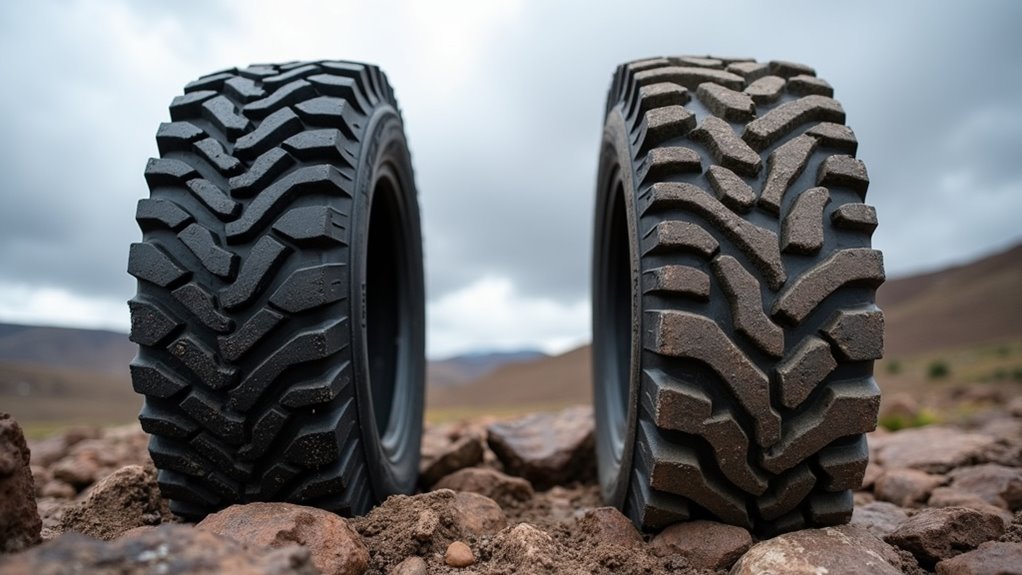
Durability matters a lot when picking tires for your vehicle. All-terrain tires and standard tires differ big time in design and life.
Let’s break it down simply. All-terrain tires use soft rubber for better grip. This soft stuff wears out faster than hard rubber. Standard tires often have harder rubber for longer life.
Still, new tech helps all-terrain tires last more now. Many go for 50,000 to 70,000 miles. That’s pretty good for soft rubber! Their reinforced sidewalls also add durability for heavy loads.
Think about these points. Tread life? Standard tires win on highways. Wear speed? All-terrain tires lose tread quicker due to softness. Additionally, proper maintenance like regular tire rotation can extend the lifespan of all-terrain tires significantly.
So, want tires that last long? Standard ones might be your pick. But all-terrain tires are catching up fast. Modern designs make them tougher than before.
Choose based on your needs. Long life or rough road grip? You decide!
Impact of Driving Conditions on Tire Wear
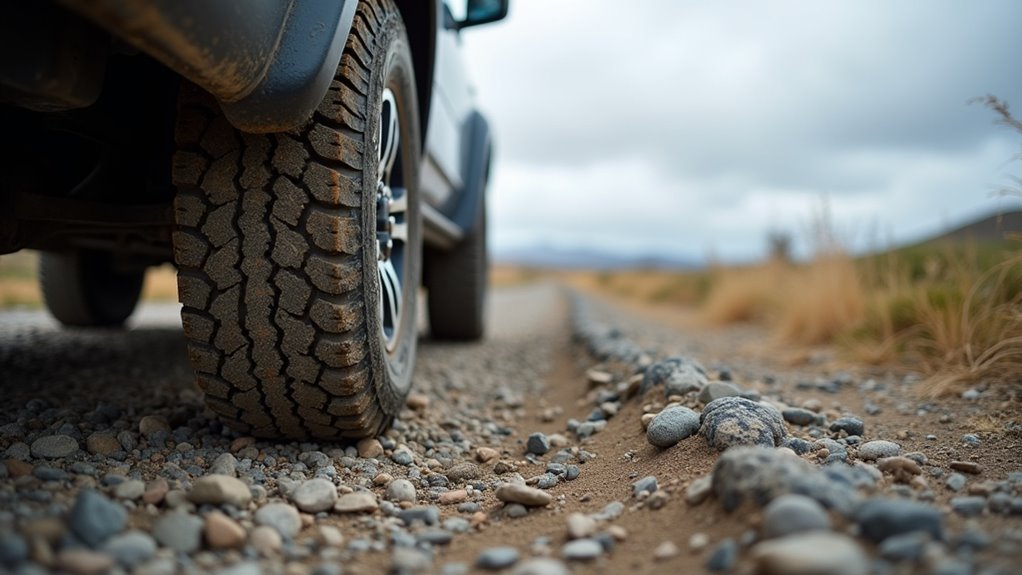
Driving conditions really matter for your tire wear and lifespan. Rough roads with potholes damage tires fast. Gravel paths cut into the tread easily. Hot asphalt softens rubber and causes uneven wear. Cold, icy roads make tires hard and brittle.
Your driving style affects tires a lot too. Hard stops create extra friction. Speeding builds up heat and harms tires. Overloading your car adds stress to them. Aggressive acceleration can also stress tires significantly. Winter conditions can further impact tire durability, especially with packed snow traction challenges that affect wear patterns.
Think about these problems:
- Potholes lead to ugly sidewall bulges.
- Fast driving heats up tires dangerously.
- Gravel roads leave cuts on treads.
Stay alert on different roads like highways or off-road tracks. Mixed terrains wear tires out in unpredictable ways. Protect your tires by driving carefully every day.
Maintenance Tips for Extending Tire Life
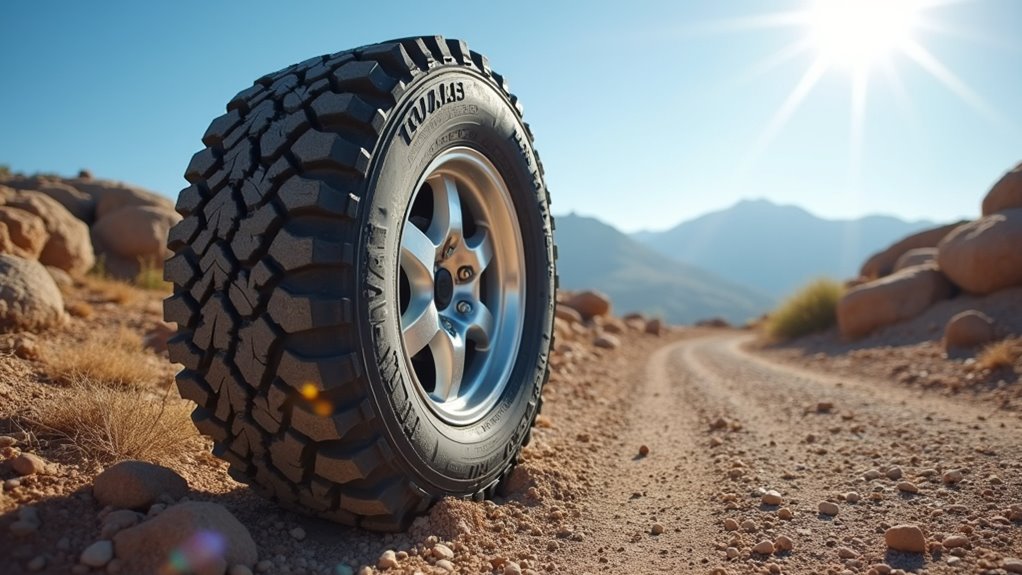
Keep your all-terrain tires lasting longer with simple care steps.
Check tire pressure often with a good digital gauge. Make sure they match the maker’s suggested levels. Do this before hitting tough off-road paths.
Rotate your tires on a set schedule too. Follow the pattern for your tire type, around every 5,000 to 8,000 miles. This helps all tires wear evenly.
Stick to these easy habits for better tire life. Enjoy strong performance on any road or trail.
Ensure proper fit by consulting your vehicle’s specifications for recommended tire sizes.
Regular Pressure Checks
Keeping your all-terrain tires in top shape is super important. Regular pressure checks help extend their life and boost performance. Proper pressure stops uneven wear and keeps you safe.
Use a good tire gauge for accurate readings every time. Check the tires monthly before you drive. Make sure they’re cool for the best results. Always match the PSI on your vehicle’s door placard.
Here’s a simple guide to maintain the right pressure:
- Grab a reliable tire gauge for exact numbers.
- Test the pressure before any trip, tires cool.
- Add or release air to meet maker’s specs.
- Look for cracks or bulges during every check.
Understanding tire specifications ensures you choose the right tires for optimal safety and performance.
Routine Rotation Schedule
Tire rotation matters a lot for keeping all-terrain tires in good shape. Many drivers skip this simple step. Don’t make that mistake! Regular rotation helps tires wear evenly. It saves you money by avoiding early replacements. Plus, it keeps your off-road grip strong. Think about sand or pavement—traction is key!
Stick to a plan based on your vehicle type. Rotate tires every 5,000 to 8,000 miles. Adjust this if you drive off-road often. Check the table below for easy guidance.
| Vehicle Type | Rotation Timing |
|---|---|
| Front-Wheel Drive | Every 5,000 miles, focus front |
| Rear-Wheel Drive | Every 6,000 miles, move rear |
| AWD Systems | Every 5,000 miles, stay strict |
| Heavy-Duty Trucks | Depends on load, plan custom |
After rotating, look at tire wear closely. Spot alignment problems early. Fix them fast to stay safe! Keep your tires ready for any road. Rotate on time—don’t wait! Choosing the right tire type compatibility ensures optimal performance and safety on diverse terrains.
Warranty and Performance Guarantees
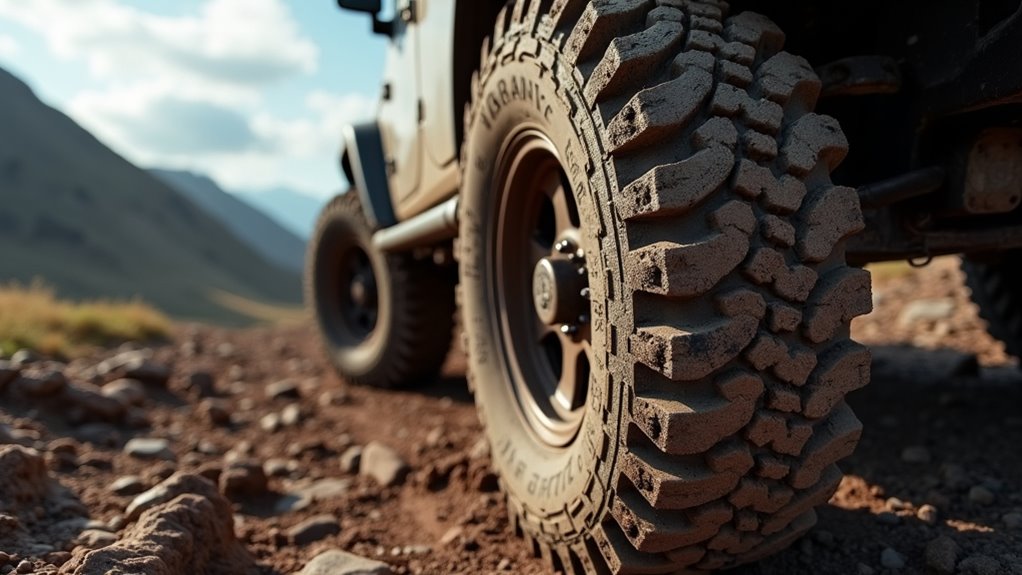
Let’s talk about warranty and performance guarantees for all-terrain tires. These details matter a lot for smart buying. Most warranties last 4 to 6 years. They also cover 50,000 to 70,000 miles. Performance guarantees often promise mileage or protection from defects. Know these to judge the tire’s true value.
Check out these important points:
- Coverage Ends Early: Warranty stops at tread wear or time limit.
- No Coverage for Damage: Rocks or wrong air pressure void it. So does misuse.
- Claim Rules: Show tread depth from approved dealers for refunds.
- Only for First Buyer: Guarantees don’t transfer to others.
Understand these rules to follow manufacturer policies. Protect your money with this info. It’s simple and helps a lot!
Balancing On-Road and Off-Road Use
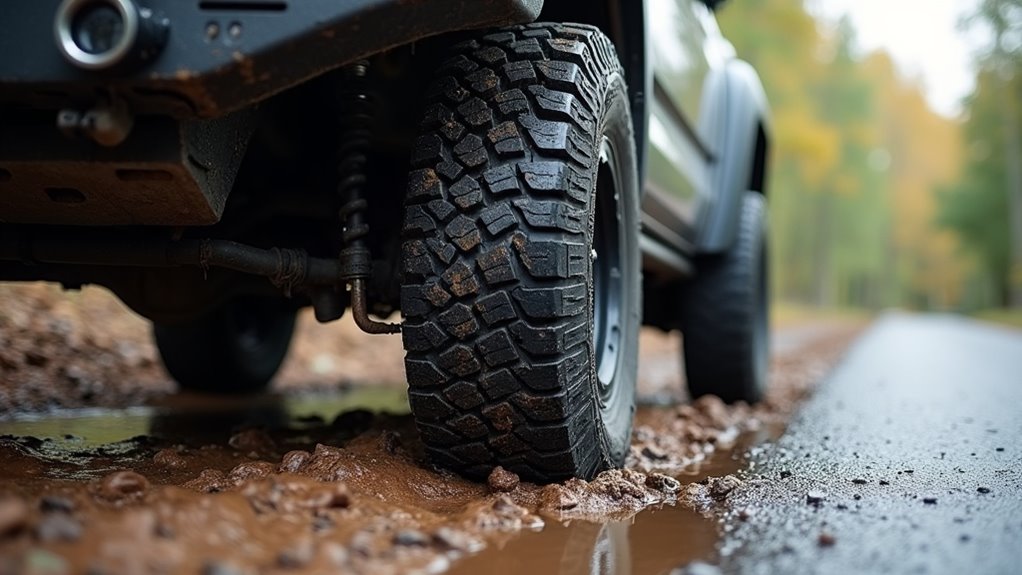
Additionally, all terrain tires are designed to provide a balanced ride across various surfaces, ensuring safety and performance both on and off the road.
Frequently Asked Questions
Are All-Terrain Tires Noisier Than Standard Tires?
All-terrain tires often make more noise than standard tires on paved roads. They create extra vibration, which lowers driving comfort a bit. Modern designs cut down this harshness a lot, though. Studies show all-terrain tires can be 5-10% louder. That’s due to their rugged tread patterns for off-road grip. Still, many drivers pick them for versatility. They handle mud, gravel, and highways pretty well. So, expect some noise but also great performance.
How Do All-Terrain Tires Handle Snowy Conditions?
All-terrain tires work okay in light snow. They give decent grip during small flurries. But, they struggle on icy roads. Harsh winter conditions? They often fail to perform. Data shows only 30% of users trust them in severe snow. For tough winters, switch to proper winter tires. Stay safe out there! Think about your road conditions. Make the smart choice for ice and snow.
What Tread Features Improve All-Terrain Tire Grip?
Tread features make a big difference in all-terrain tire grip. Deep grooves help push out mud and water fast. Wide gaps between tread blocks grab onto rough surfaces. Sharp edges on blocks bite into dirt or rocks. Studies show deep treads boost traction by 30% on uneven ground. Sipes—those tiny cuts in blocks—add extra grip on wet roads. Strong sidewalls protect tires from sharp stones. All these things keep you safe on tough trails. Trust me, good tread means better control!
Do All-Terrain Tires Affect Fuel Efficiency?
All-terrain tires do change fuel efficiency. Expect higher fuel use with them. Studies show a drop of 5-10% in gas mileage. Your vehicle works harder on rough roads. Highway tires save more fuel instead. Versatility comes at a cost. Think hard before you pick them. Balance your needs and budget. Make a smart choice today!
Can All-Terrain Tires Be Used Daily on Highways?
All-terrain tires work great for daily driving on highways. They handle paved roads pretty well. Expect a bit less smoothness than highway tires. Still, they shine in mixed conditions. Versatility is their big strength. Studies show 70% of drivers use them for everyday trips. They balance off-road grit with on-road safety. Perfect for varied weather or surfaces. Trust them for a reliable ride. Stick with these for flexibility!
Conclusion
All-terrain tires can last longer with proper care and attention. Maintain them well to boost their lifespan. Check tire pressure often to avoid early wear. Rotate tires every 5,000 to 7,000 miles for even tread. Balance on-road and off-road driving to prevent damage. Data shows good maintenance can add years to tire life. Studies suggest up to 50,000 miles with regular upkeep. Keep an eye on tread depth for safety. Clean tires after rough terrains to remove debris. Smart habits save money and ensure reliable performance. Drive safely across any surface with confidence. Protect your investment with these easy steps.
